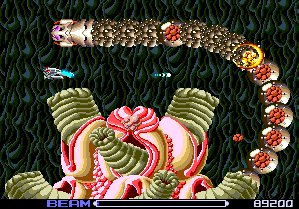|
||||||
  R-Type's dazzlingly imaginative, semi-organic creations betray the influence of HR-Giger - but Irem had other sources of inspiration too (above). It's graphics, however, were only one of a series of breathtaking innovations.
|
The cult shooter to end all cult In recent
years the re-release of so-called 'classics' from the
annals of coin-op gaming history has, more often than
not, been a desperately sobering experience. Many games
once revered as distinguished examples of a genre, simply
can't cut it in today's polygon-obsessed games market. A
common problem is that simplistic and dated visuals can
now undermine the desire to progress through a game's
levels - the goalposts have been shifted and a whole new
set of expectations are in place. Ultimately though, the
intervening years have seen a progression in certain
types of arcade-style gameplay and nostalgia is often the
only motivation left in retrogaming.
Irem's
classic shooter may now be a relic from a dated genre
(with an inherently simple game structure to boot) but it
pioneered graphic and game design blueprints that set
incredibly high standards - standards that were so far
ahead of their time that they still impress today. It's
difficult to think of another game that so vividly
exemplifies a developer having strived for perfection in
every vital area of a game's creation.
R-Type's success in the arcades meant that conversion to various home computers and consoles was a certainty, and it was NEC's diminutive but potent PC Engine (aka Turbografix 16) console that first played host (the pictures on this page are from this version- Mike.) Fortunately for NEC (and thanks to the skillful conversion team at Huson Soft), PC-E R-Type was virtually arcade perfect and was released on two seperate 'HuCards' - each containing four of the game's 8 levels. Despite this, the leap in performance over the most popular consoles of the day, such as the NES, was all too apparent and R-Type was the 'killer app' NEC needed to transform its machine into a gameplayer's dream. PC Engines flew off the shelves, and many even made it over to the UK, kickstarting the grey import market in the process. (continued..) |
|
| R-Type I
and II (below left & middle) can aslo be enjoyed in
the M72 and Rage
emulators on PC, however the third arcade sequel, R-Type Leo (below, right) is unfortunately as yet unemulated.
|
||